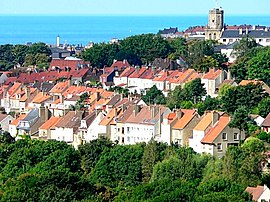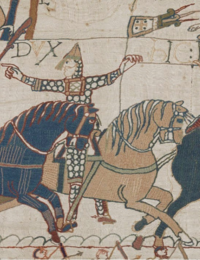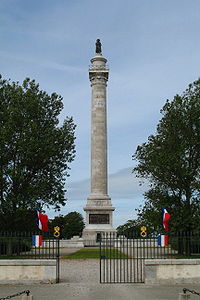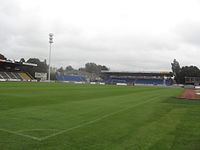Boulogne-sur-Mer
Boulogne-sur-Mer
Boulonne-su-Mér ( West Flemish) | |
|---|---|
Subprefecture and commune | |
 A general view from the Brecquerecque Quarter: The modern lighthouse, the medieval bell tower and the English Channel | |
| Coordinates: 50°43′35″N 1°36′53″E / 50.7264°N 1.6147°E | |
| Country | France |
| Region | Hauts-de-France |
| Department | Pas-de-Calais |
| Arrondissement | Boulogne-sur-Mer |
| Canton | Boulogne-sur-Mer-1 and 2 |
| Intercommunality | CA du Boulonnais |
| Government | |
| • Mayor (2020–2026) | Frédéric Cuvillier[1] (PS) |
| Area 1 | 8.42 km2 (3.25 sq mi) |
| • Urban | 62.8 km2 (24.2 sq mi) |
| • Metro | 667 km2 (258 sq mi) |
| Population (2021)[2] | 40,910 |
| • Density | 4,900/km2 (13,000/sq mi) |
| • Urban (2018[3]) | 84,676 |
| • Urban density | 1,300/km2 (3,500/sq mi) |
| • Metro (2018[3]) | 160,130 |
| • Metro density | 240/km2 (620/sq mi) |
| Demonym | Boulonnaise |
| Time zone | UTC+01:00 (CET) |
| • Summer (DST) | UTC+02:00 (CEST) |
| INSEE/Postal code | 62160 /62200 |
| Elevation | 0–110 m (0–361 ft) |
| Website | http://www.ville-boulogne-sur-mer.fr/ |
| 1 French Land Register data, which excludes lakes, ponds, glaciers > 1 km2 (0.386 sq mi or 247 acres) and river estuaries. | |
Boulogne-sur-Mer (French:
Boulogne is an ancient town and was the main Roman port for trade and communication with its Province of Britain. After a period of Germanic presence following the collapse of the Empire, Boulogne was integrated into the County of Boulogne of the Kingdom of France during the Middle Ages. It was occupied by the Kingdom of England numerous times due to conflict between the two nations. In 1805 it was a staging area for Napoleon's troops for several months during his planned invasion of the United Kingdom.
The city's 12th-century belfry is recognised by
Name
The French name Boulogne derives from the
History
Origin of the city
The foundation of the city known to the Romans as Gesoriacum is credited to the
The city was an important town of the Morini (the 'sea people'), and Zosimus called it Germanorum ("Germanic-speaking") at the end of the 4th century.[11]
Middle Ages

In the
The area was fought over by the French and the English, including several English occupations during the course of the
19th century

Boulogne received its current status as a
The 19th century was a prosperous one for Boulogne, which became a
A nephew of Napoleon Bonaparte, Louis-Napoleon Bonaparte (subsequently the emperor Napoleon III), returned to France in secret from his exile in Britain, passing through Boulogne in August 1840. He was later jailed for trying to lead a revolt in Strasbourg.
World wars
During the
Until June 1918, the dead from the hospitals at Boulogne were buried in the Cimetiere de L'Est, one of the town's cemeteries, the Commonwealth graves forming a long, narrow strip along the right hand edge of the cemetery. In the spring of 1918, it was found that space was running short in the Eastern Cemetery in spite of repeated extensions to the south and the site of the new cemetery at Terlincthun was chosen.[14] It also was the site of an Allied (French and British) armaments production conference.

On 22 May 1940 during the
To replace the destroyed urban infrastructure, affordable housing and public facility projects in functional,
Geography

Location
Boulogne-sur-Mer is in Northern France, at the edge of the Channel and in the mouth of the river Liane. In a direct line, Boulogne is approximately at 30 kilometres (19 miles) from Calais, 50 kilometres (31 miles) from Folkestone, 100 kilometres (62 miles) from Lille and Amiens, 150 kilometres (93 miles) from Rouen and London and 215 kilometres (134 miles) from Paris.
Boulogne is a relatively important city of the North, exercising an influence on the
Urbanization

The city is divided into several parts :
- City centre : groups historic and administrative buildings, and also accommodations, stores, banks, churches, pedestrian streets and places.
- Fortified town : old-town where are a lot of historic monuments (the castle-museum, the basilica, the belfry, the imperial palace) and also the city hall and the courthouse. it is surrounded by 13th-century ramparts very appreciated today by walkers.
- Gambetta-Sainte-Beuve : tourist area situated in the northwest of the city, on the edge of the beach and the recreational harbour.
- Capécure : economic and industrial area, situated in the west of the city, around the harbour.
- Saint-Pierre (Saint Peter) : former neighborhood of the fishermen, destroyed during World War II and reconstructed after.
- Chemin Vert (Green path) : zone created in the 1950s, knowing today poverty and unemployment. it is the neighborhood of Franck Ribéry.
- Dernier Sou (Last penny) : residential area situated in the east of the city.
- Beaurepaire (Beautiful hideout) : residential area situated in the north of the city.
- Bréquerecque : residential area situated in the south of the city.
Climate
Boulogne-sur-Mer has an
| Climate data for Boulogne-sur-Mer (1991–2020 normals), humidity 1973–1990, extremes since 1973 | |||||||||||||
|---|---|---|---|---|---|---|---|---|---|---|---|---|---|
| Month | Jan | Feb | Mar | Apr | May | Jun | Jul | Aug | Sep | Oct | Nov | Dec | Year |
| Record high °C (°F) | 16.4 (61.5) |
18.9 (66.0) |
22.7 (72.9) |
26.0 (78.8) |
31.2 (88.2) |
33.3 (91.9) |
39.6 (103.3) |
34.8 (94.6) |
32.6 (90.7) |
27.2 (81.0) |
20.0 (68.0) |
17.2 (63.0) |
39.6 (103.3) |
| Mean maximum °C (°F) | 11.7 (53.1) |
12.5 (54.5) |
16.7 (62.1) |
20.8 (69.4) |
25.0 (77.0) |
27.4 (81.3) |
29.1 (84.4) |
29.0 (84.2) |
25.1 (77.2) |
20.6 (69.1) |
15.8 (60.4) |
12.4 (54.3) |
31.3 (88.3) |
| Mean daily maximum °C (°F) | 7.1 (44.8) |
7.3 (45.1) |
9.7 (49.5) |
12.7 (54.9) |
15.4 (59.7) |
18.1 (64.6) |
20.1 (68.2) |
20.7 (69.3) |
18.5 (65.3) |
14.9 (58.8) |
10.8 (51.4) |
7.9 (46.2) |
13.6 (56.5) |
| Daily mean °C (°F) | 5.3 (41.5) |
5.4 (41.7) |
7.4 (45.3) |
9.8 (49.6) |
12.7 (54.9) |
15.3 (59.5) |
17.4 (63.3) |
18.0 (64.4) |
15.8 (60.4) |
12.6 (54.7) |
8.8 (47.8) |
6.0 (42.8) |
11.2 (52.2) |
| Mean daily minimum °C (°F) | 3.4 (38.1) |
3.4 (38.1) |
5.0 (41.0) |
7.0 (44.6) |
9.8 (49.6) |
12.5 (54.5) |
14.7 (58.5) |
15.3 (59.5) |
13.2 (55.8) |
10.3 (50.5) |
6.8 (44.2) |
4.1 (39.4) |
8.8 (47.8) |
| Mean minimum °C (°F) | −3.7 (25.3) |
−3.0 (26.6) |
0.1 (32.2) |
2.1 (35.8) |
5.2 (41.4) |
9.0 (48.2) |
11.6 (52.9) |
11.8 (53.2) |
9.1 (48.4) |
4.6 (40.3) |
1.2 (34.2) |
−2.4 (27.7) |
−5.3 (22.5) |
| Record low °C (°F) | −13.4 (7.9) |
−13.6 (7.5) |
−7.8 (18.0) |
−2.0 (28.4) |
1.6 (34.9) |
4.0 (39.2) |
8.0 (46.4) |
9.0 (48.2) |
5.8 (42.4) |
−1.0 (30.2) |
−5.6 (21.9) |
−9.6 (14.7) |
−13.6 (7.5) |
| Average precipitation mm (inches) | 77.0 (3.03) |
56.0 (2.20) |
48.0 (1.89) |
48.1 (1.89) |
54.6 (2.15) |
48.0 (1.89) |
54.3 (2.14) |
63.2 (2.49) |
69.6 (2.74) |
95.8 (3.77) |
106.8 (4.20) |
103.1 (4.06) |
824.5 (32.45) |
| Average relative humidity (%)
|
87 | 85 | 84 | 81 | 81 | 81 | 82 | 81 | 82 | 83 | 85 | 87 | 83.3 |
| Source 1: Infoclimat (1991–2020 normals) [17] | |||||||||||||
| Source 2: Infoclimat (humidity 1973–1990)[18] | |||||||||||||
Transport

Boulogne is close to the
The city has several railway stations, of which the most important is
Boulogne has no cross channel ferry services since the closure of the route to Dover by LD Lines in 2010.[citation needed]
The regional trains are
Sights


Boulogne's 12th-century belfry is one of 56 listed
Other than the belfry there are also the following sights:
- Medieval walls 1,500 metres long, with 4 gates and 17 towers from the 13th century
- Medieval castle, whose foundations date to Roman times. It houses an Egyptian art collection, and the ancient Greek Suicide of Ajax Vase.
- Gothic church of St Nicholas, housing several 15th-century statues
- Cathedral basilica of Notre-Dame, with a dome standing at over 100 m. The crypt is one of the largest in France, and has Roman, Romanesque and Gothic elements.
- Opened in 1991, Nausicaä– The French National Sea Centre is a science centre entirely dedicated to the relationship between mankind and the sea. It houses Aquaria, exhibitions on marine fauna, and the exploitation and management of marine resources (fisheries, aquaculture, coastal planning, maritime transport, exploitation of energies and mineral, tourism).
- The Boulogne Eastern Cemetery, created during the Great War
- Colonne de la Grande Armée – Statue of Napoleon I
Economy
Boulogne-sur-Mer is an important fishing port, with 7,000 inhabitants deriving part, or all, of their livelihoods from fishing.
IFREMER (the French Research Institute for Exploitation of the Sea) and the Pasteur Institute are located in Boulogne Port.
Certain brands, including Crown and Findus, have regional offices in Boulogne.
Media
- Radio : France Bleu Nord, Virgin Radio Côte d'Opale
- Television : France 3 Côte d'Opale
- Print : La Voix du Nord(édition de Boulogne sur Mer), La Semaine dans le Boulonnais, Touzazimut
Events
In 1905, the first World Esperanto Congress was held in Boulogne-sur-Mer, where the historic Declaration of Boulogne was ratified. L. L. Zamenhof, the creator of Esperanto, was among the attendees. In 2005, there was an anniversary celebration to mark the centenary with more than 500 attendees.
Administration
- Boulogne is the seat of the Communauté d'agglomération du Boulonnais
| Duration | Name | Party | Particularities |
|---|---|---|---|
| 2014–2020 | Frédéric Cuvillier | PS | Deputy, Minister |
| 2012–2014 | Mireille Hingrez-Céréda | PS | |
| 2004–2012 | Frédéric Cuvillier | PS | Deputy, Minister |
| 1996–2004 | Guy Lengagne | PS | Deputy, Minister |
| 1989–1996 | Jean Muselet | Conservative | |
| 1977–1989 | Guy Lengagne | PS | Deputy, Minister |
| 1945–1977 | Henri Henneguelle | PS |
Population
In 2018, 40,664 people lived in the city, while its metropolitan area had a population of 160,130.[3]
|
| ||||||||||||||||||||||||||||||||||||||||||||||||||||||||||||||||||||||||||||||||||||||||||||||||||||||||||||||||||
| |||||||||||||||||||||||||||||||||||||||||||||||||||||||||||||||||||||||||||||||||||||||||||||||||||||||||||||||||||
| Source: EHESS[20] and INSEE (1968-2017)[21] | |||||||||||||||||||||||||||||||||||||||||||||||||||||||||||||||||||||||||||||||||||||||||||||||||||||||||||||||||||
Education
Boulogne-sur-Mer hosts one of the oldest Universités de l'été – summer courses in French language and culture. It is known as the Université d'été de Boulogne-sur-Mer.
The Saint-Louis building of the University of the Côte d'Opale's Boulogne campus opened its doors in 1991, on the site of the former St. Louis Hospital, the front entrance to which remains a predominant architectural feature. Its 6 major specialisms are Modern Languages, French Literature, Sport, Law, History and Economics. The university is situated in the town centre, about 5 minutes[clarification needed] from the Boulogne Tintelleries railway station.
University
- Campus Université Lille Nord de France.
Public primary and secondary
- High schools : Lycée Auguste Mariette, Edouard Branly, Cazin (professional).
- College : College Langevin, Angelier, Daunou.
Private primary and secondary
- High schools: Lycée Nazareth, Haffreingue, Saint-Joseph
- College: College Godefroy de Bouillon, Haffreingue, Nazareth, Saint-Joseph
Health
Two health centres are located in Boulogne, the public Hospital Duchenne and the private Clinique de la côte d'opale.
Sports

Boulogne's football club,
Basketball teams in Boulogne include
Culture
The Château de Boulogne-sur-Mer (now a castle museum) of Boulogne, in the fortified town, houses the most important exhibition of masks from Alaska in the world, the second largest collection of Greek ceramics in France (after the Louvre), collections of Roman and medieval sculptures, paintings (15th–20th century), an Egyptian collection, African Arts etc. As these collections are exhibited in a medieval castle, one can also discover the Roman walls (in the underground) as well as rooms built in the 13th century (La Barbière, banqueting hall, chapel, covered parapet walk...)

La Casa San Martin is currently a museum where José de San Martín the leader of independence struggle in Argentina (also Chile and Peru) died in 1850, from 1930 to 1967 this house was the consulate of Argentina in France. There is a statue dedicated to his colleague Simón Bolívar, other liberator of South America in the revolutions against Spanish colonial rule in the 1810s. Bolivar planned to head in exile to this very part of France before his death in 1830. Historic emigration in the 19th century from the Nord-Pas de Calais region to Argentina and Chile can explain some cultural ties with South America of the Boulognais and Latino/Ibero-American culture. [citation needed]
Food
As an international maritime port on the English Channel (La Manche), the town of Boulogne-sur-Mer has European and American influences in local cuisine. They include:
- Welsh rarebit (from Wales, United Kingdom)
- Sandwich américain (an American sandwich introduced from the US)
- Kipper (Flemish: smoked herring)
Notable people
Born in Boulogne

- Guynemer (fl. 1090s), pirate.
- Matilda of Boulogne (1105–1152), Countess of Boulogne and queen consort of England; the wife of Stephen, King of England(reigned 1135–1154).
- Michel Le Quien (1661–1733), monk and historian.
- Pierre Claude François Daunou (1761–1840), politician and historian.
- Frédéric Sauvage (1786–1857), engineer and a pioneer of the propeller.
- Charles Augustin Sainte-Beuve (1804–1869), literary critic and one of the major figures of French literary history.
- neurologist.
- Auguste Delacroix (1809-1868), painter.
- Auguste Mariette (1821–1881), scholar and archaeologist, one of the foremost Egyptologists of his generation, and the founder of the Egyptian Museum in Cairo.
- Joseph O'Kelly (1828–1885), composer and pianist.
- Auguste O'Kelly (1829–1900), music publisher.
- Charles Frédéric O'Kelly (1830–1897), managing director of Blanzy-Poure.
- George O'Kelly (1831–1914), pianist and composer.
- Alexandre Guilmant (1837–1911), organist/composer.
- Étienne-Prosper Berne-Bellecour (1838–1910), painter.
- Benoît-Constant Coquelin (1841–1909), actor.
- Ernest Hamy (1842–1908), anthropologist/ethnologist; created (in 1880) the museum of ethnography of Trocadéro (today known as the Musée de l'Homme, Trocadéro).
- Ernest Alexandre Honoré Coquelin (1848–1909), actor.
- Cathedral of Notre Dame in Paris, and professor at the Paris Conservatory.
- Henri Malo (1868–1948), writer and historian.
- Léo Marjane (1912–2016), singer.
- Georges Mathieu (1921–2012), famous painter, initiator of "lyrical abstraction" and informal art.
- Michel Caffier (born 1930), writer and literary critic.
- Sophie Daumier (1934–2004), film actress.
- Estha Essombe (born 1963), judoka.
- Jean-Pierre Papin (born 1963), footballer.
- David Ringot (born 1969), footballer.
- Mickaël Bourgain (born 1980), track cyclist.
- Franck Ribéry (born 1983), footballer.
- Terence Makengo (born 1992), footballer.
Others associated with Boulogne

- Godfrey of Bouillon (c.1060–1100), Count of Boulogne, prominent figure in the First Crusade
- Baldwin I of Jerusalem (c.1058–1118), Count of Boulogne, prominent figure in the First Crusade
- Blaise de Monluc(1502–1577), Marshal of France
- Richard Martin (1754–1834), Irish parliamentarian and animal rights campaigner; exiled to Boulogne in 1826, where he died
- Smithson Tennant (1761–1815), chemist, discoverer of osmium and iridium, died falling from a bridge in Boulogne
- debtor's prison. He lived there for several years, and met his wife during this period.
- Adam Liszt (1776–1827), father of Franz Liszt, died from Typhoid fever while on a vacation
- José de San Martín (1778–1850), Argentine general who liberated Argentina, Chile and Peru; lived for two years in Boulogne and died there
- John Short Hewett (1781–1835), British cleric and academic, died there
- Benoît-Agathon Haffreingue(1785–1871), priest and builder of Boulogne's cathedral
- Félix Godefroid (1818–1897), Belgium-born composer, grew up in Boulogne
- Constant Coquelin(1841–1909), actor
- In Flanders Field
- Alfred-Georges Regner (1902–1987), painter-engraver
- Maurice Boitel (1919–2007), painter
- Olivier Latry (born 1962), musician, educator
- Grégory Thil (born 1980), footballer
- N'Golo Kanté (born 1991), footballer
- Randal Kolo Muani (born 1998), footballer
International relations
This section needs additional citations for verification. (April 2017) |
Boulogne-sur-Mer is
- Folkestone, Kent, United Kingdom[24]
- La Plata, Argentina
- Safi, Morocco – since 2007
- Deux-Ponts (Zweibrücken), Germany – since 1959
See also
- Boulonnais (land area)
- First Siege of Boulogne
- Itius Portus
- Vieux-Boulogne
References
- ^ "Répertoire national des élus: les maires". data.gouv.fr, Plateforme ouverte des données publiques françaises (in French). 2 December 2020.
- ^ "Populations légales 2021". The National Institute of Statistics and Economic Studies. 28 December 2023.
- ^ a b c Comparateur de territoire, INSEE, retrieved 20 June 2022.
- ^ "C'est l'Actu juillet 2010". Ville-boulogne-sur-mer.fr. Archived from the original on 21 August 2013. Retrieved 26 March 2013.
- ^ Téléchargement du fichier d'ensemble des populations légales en 2017, INSEE
- ^ "Boulogne-sur-Mer Tourist Guide". Information France. 1 June 2010. Archived from the original on 14 March 2013. Retrieved 8 August 2020.
- ^ a b "Les Beffrois au patrimoine de l'Humanité". Nordmag.fr. Archived from the original on 18 March 2013. Retrieved 26 March 2013.
- ^ Suetonius, The Twelve Caesars: Gaius (Caligula), chapter 46.
- ^ a b c "Boulogne-sur-Mer (Municipality, Pas-de-Calais, France)". Flagspot.net. Archived from the original on 15 May 2013. Retrieved 26 March 2013.
- ISBN 0-520-08326-1.
- ^ Historia Nova, Book VI.5.2–3
- ISBN 92-5-100513-3.
- ^ Boulogne-sur-Mer (Municipality, Pas-de-Calais, France) - "Boulogne was proclaimed in 1803 an Imperial Town."
- ^ "Boulogne Eastern Cemetery". Commonwealth War Graves Commission. Archived from the original on 1 November 2014. Retrieved 13 August 2014.
- ^ "2nd Battalion Irish Guards. – World War 2 Talk". Ww2talk.com. Archived from the original on 27 July 2011. Retrieved 3 July 2012.
- ^ Stacey, C P (1966). "Clearing the Coastal Belt and the Ports September 1944 – Operation "WELLHIT"; The Capture of Boulogne". Official History of the Canadian Army. Department of National Defence. Archived from the original on 12 January 2010. Retrieved 24 June 2009.
- ^ a b c "Normales et records climatologiques 1991-2020 à Boulogne" (in French). Infoclimat. Retrieved 11 September 2023.
- ^ "Normes et records 1961–1990: Boulogne (62) – altitude 73m" (in French). Infoclimat. Retrieved 8 January 2016.
- ^ "Belfries of Belgium and France". UNESCO World Heritage Centre. United Nations Educational, Scientific, and Cultural Organization. Retrieved 5 November 2021.
- ^ Des villages de Cassini aux communes d'aujourd'hui: Commune data sheet Boulogne-sur-Mer, EHESS (in French).
- ^ Population en historique depuis 1968, INSEE
- ^ "Football Boulogne : Union Sportive Boulogne Côte d Opale (USBCO)". Foot-national.com. Archived from the original on 19 March 2013. Retrieved 26 March 2013.
- ^ Franck Ribéry – Goal.com Archived 6 March 2016 at the Wayback Machine
- ^ "British towns twinned with French towns [via WaybackMachine.com]". Archant Community Media Ltd. Archived from the original on 5 July 2013. Retrieved 12 July 2013.
Further reading
- "Boulogne", A Handbook for Travellers in France (8th ed.), London: John Murray, 1861, OL 24627024M
- "Boulogne-sur-Mer", Northern France (3rd ed.), Leipsic: Karl Baedeker, 1899, OL 24872324M
- . Encyclopædia Britannica. Vol. 4 (9th ed.). 1878. pp. 171–172.
- . Encyclopædia Britannica. Vol. 4 (11th ed.). 1911. pp. 323–324.
External links
- Website about Boulogne-sur-Mer (English only)
- IGN (in English)
- Official website: Tourism in Boulogne sur Mer and the Boulonnais area (in English)
- Boulogne-sur-Mer city council website (in French)
- Visiting Boulogne-sur-Mer (English guide and tourist map)
- NAUSICAÄ's official website (in French and English)
- Boulogne 2005 Esperanto
- Universite d'ete de Boulogne-sur-Mer Archived 23 May 2017 at the Wayback Machine
- The university library of ULCO
- The Boulogne Eastern Cemetery on the website "Remembrance Trails of the Great War in Northern France"





